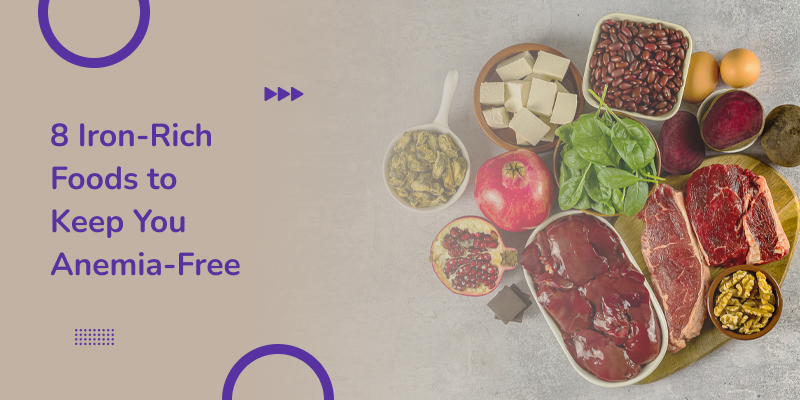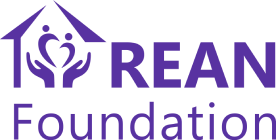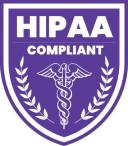
8 Iron-Rich Foods to Keep You Anemia-Free
Anemia is probably one of the most commonly known diseases around the world. But did you know there are many different types of this disease, and the most common type is Iron-Deficiency Anemia?
Iron-Deficiency Anemia: What You Should Know About It
To say that iron is an essential nutrient is an understatement. Your body relies heavily on this mineral to function correctly. Basically, iron is what helps the red blood cells to transport oxygen from the lungs to all the other parts of your body. It also helps store oxygen in the muscle tissues, aids in brain development and facilitates the normal functioning of cells.
For all these functions to happen usually, we require about 18 milligrams of iron every day. It is also known as the Daily Value or DV.
The iron required for our body comes from numerous plants and animals. So, there really is no dearth of iron-rich food sources. However, a consistent lack of iron in the diet can cause iron-deficient Anemia or IDA, which hinders the production of Hemoglobin. This protein is responsible for two things:
- It gives your blood its distinct red color.
- It carries oxygen throughout your body.
A person with IDA will experience any of the following symptoms:
- Shortness of breath
- Brittle nails
- Persistent fatigue
- Coldness in the limbs
- Irregular heartbeat
- Chest pain and headaches
- Dryness or soreness on the tongue
- Pallor of the skin
- Anxiety and depression
- Peculiar craving for ice
So how does iron-deficient Anemia differ from other types of Anemia?
Although they carry the same name, other anemia types, like Vitamin Deficiency Anemia and Pernicious Anemia result from a lack of B12 and Folate. Anemia also occurs due to acute loss of blood due to excessive internal or external bleeding and also due to the destruction of RBCs in the bloodstream. This is known as Hemolytic Anemia. IDA is different from these forms of Anemia because it is caused by iron deficiency and not by the loss of blood.
It is, therefore, understandable that IDA is more easily curable than other complicated types of Anemia. You can increase hemoglobin levels in your body by adding iron-rich food to your regular diet to prevent iron deficiency.
Food-based iron comes in two forms: Heme and Non-heme. Heme refers to all the iron-rich foods sourced from animals. Non-heme includes all the plant-based foods abundant in iron. So, what should you eat to have adequate iron levels in your diet? Let’s explore the options.
Incredible Eight: Iron-Rich Food Sources to Prevent Anemia
1. Green Leafy Vegetables
When it comes to non-heme iron sources, there’s nothing to beat leafy green veggies like:
- Kale
- Spinach
- Moringa
- Swiss chard
- Dandelion greens
- Collard greens
These greens are fiber-rich and packed with iron, protein, calcium, and Vitamins A, C, and E. Collard greens and Swiss chard, in particular, are rich in Vitamin C, which is essential for the absorption of iron. Kale and spinach are abundantly rich in nutrients but have very few calories.
According to the USDA, a cup of boiled spinach delivers about 3.72mg of iron. 100 gms of spinach will contain approximately 2.7 mg of iron, which is 15% of your Daily Value.
2. Legumes
Under the legume category are your dhals, lentils, beans, chickpeas, soybeans, black beans, navy beans, kidney beans, and double beans. Legumes are also great sources of micronutrients like folates, potassium, and magnesium. Cooked lentils like pigeon peas and split green gram are especially rich in iron. Sources say that about 168 gms of cooked lentils contain about 6.6 mg or 37% DV of iron.
The other biggest iron source in this category is the humble black beans. Just half a cup or 86 gms of black beans gives you 10% DV of iron. Legumes are excellent iron sources for pure vegetarians.
3. Nuts & Seeds
Walnuts, almonds, hazelnuts, pumpkin seeds, cucumber seeds, sunflower seeds, pecans, and pistachios should never be underestimated for their small size. Add these nuts and seeds to your breakfast muffins and cereals, or simply grab a handful when you feel hungry. They will keep you satiated and deliver your daily dosage of iron and fiber.
4. Dried Fruits
Everything from golden raisins, black raisins, and dried apricots to dates and dried figs are packed with iron, calcium, and magnesium. A handful of dried fruits daily helps build a robust immune system and maintain optimum haemoglobin levels.
5. Tofu
This popular soy-based Asian food abounds with iron, thiamine, calcium, selenium, and magnesium. In a half-cup (126-gram) serving, there is 3.4 mg of iron, which equals 19% of the daily value. A single serving of tofu will give you 22 grams of protein.
Besides, the Isoflavones in tofu have been linked to improved insulin sensitivity, decreased heart disease risk, and relief from menopausal symptoms.
6. Meat
Animal-based heme-rich foods include mutton, beef, pork, poultry, and eggs. Red meat, especially, has been long associated as a quick cure for Anemia. While meat is rich in protein, zinc, copper, selenium, and B vitamins, it is also very satiating and satisfying. Sources say that a 100gm serving of ground beef has 2.7 milligrams of iron, or about 15% of the daily requirement.
7. Offal or Organ Meats
Not everyone is fond of organ meats like liver, kidney, spleen, bone marrow, brain, heart, etc. Organ meats are an acquired taste. However, they are packed with iron, protein, calcium, selenium, and magnesium- all of which are essential for your body. The beef liver, for example, has both iron and Vitamin A in abundance. One 100 gm serving of beef liver provides 36% of the daily value of iron, which translates to 6.5mg. The Dv of Vitamin A in the same amount of beef liver is a whopping 1,049%. Aside from that, organ meat is an excellent source of choline, an essential nutrient for brain and liver health.
.
Point to note: It is essential to limit your intake of both red meat and organ meat, as they are also super-rich in fat which is not very conducive to the health of your heart.
Also Read: Stay Steady & Age Gracefully- Balance Exercises for Seniors
8. Seafood
If you love seafood, especially oysters, clams, scallops, crabs, and shrimp, you will never have to worry about becoming anemic. Seafood and shellfish are some of the richest sources of heme iron (with the exception of some clam types being poor in iron). A 100-gm serving of iron-rich clams has about 3mg or 17% of the Daily Value.
If you are looking for iron-rich seafood, go for:
- Fresh or canned tuna
- Mahi Mahi
- Mackerel
- Sardines
- Pompano
- Fresh or canned salmon
- Perch
There’s a good reason why doctors stress the intake of iron-rich foods: Your body cannot produce iron on its own. That’s why it should be consumed regularly. Vegetarians and vegans can include Vitamin C in their diet to increase the absorption of non-heme iron. Moreover, if you are having trouble getting enough iron from food sources, you may need an iron supplement.
Staying Healthy With REAN
How will you know if you are getting the required dosage of iron every day? Simple- through the REAN HeathGuru app. Created by REAN Foundation, our AI-powered app helps diagnose Anemia through non-invasive techniques. Using the app, your doctors or even you can scan your tongue, palm, nails, and eyes for signs of Anemia.
The app is a blessing for medical teams and people in remote areas. Its user-friendly design enables even non-tech-savvy persons to monitor their condition and seek medical help on time. In short, REAN HealthGURU makes early detection and prevention of Anemia possible.
Talk to our experts about how to use the app to your advantage. Call us today.
Anemia is probably one of the most commonly known diseases around the world. But did you know there are many different types of this disease, and the most common type is Iron-Deficiency Anemia?
Iron-Deficiency Anemia: What You Should Know About It
To say that iron is an essential nutrient is an understatement. Your body relies heavily on this mineral to function correctly. Basically, iron is what helps the red blood cells to transport oxygen from the lungs to all the other parts of your body. It also helps store oxygen in the muscle tissues, aids in brain development and facilitates the normal functioning of cells.
For all these functions to happen usually, we require about 18 milligrams of iron every day. It is also known as the Daily Value or DV.
The iron required for our body comes from numerous plants and animals. So, there really is no dearth of iron-rich food sources. However, a consistent lack of iron in the diet can cause iron-deficient Anemia or IDA, which hinders the production of Hemoglobin. This protein is responsible for two things:
- It gives your blood its distinct red color.
- It carries oxygen throughout your body.
A person with IDA will experience any of the following symptoms:
- Shortness of breath
- Brittle nails
- Persistent fatigue
- Coldness in the limbs
- Irregular heartbeat
- Chest pain and headaches
- Dryness or soreness on the tongue
- Pallor of the skin
- Anxiety and depression
- Peculiar craving for ice
So how does iron-deficient Anemia differ from other types of Anemia?
Although they carry the same name, other anemia types, like Vitamin Deficiency Anemia and Pernicious Anemia result from a lack of B12 and Folate. Anemia also occurs due to acute loss of blood due to excessive internal or external bleeding and also due to the destruction of RBCs in the bloodstream. This is known as Hemolytic Anemia. IDA is different from these forms of Anemia because it is caused by iron deficiency and not by the loss of blood.
It is, therefore, understandable that IDA is more easily curable than other complicated types of Anemia. You can increase hemoglobin levels in your body by adding iron-rich food to your regular diet to prevent iron deficiency.
Food-based iron comes in two forms: Heme and Non-heme. Heme refers to all the iron-rich foods sourced from animals. Non-heme includes all the plant-based foods abundant in iron. So, what should you eat to have adequate iron levels in your diet? Let’s explore the options.
Incredible Eight: Iron-Rich Food Sources to Prevent Anemia
1. Green Leafy Vegetables
When it comes to non-heme iron sources, there’s nothing to beat leafy green veggies like:
- Kale
- Spinach
- Moringa
- Swiss chard
- Dandelion greens
- Collard greens
These greens are fiber-rich and packed with iron, protein, calcium, and Vitamins A, C, and E. Collard greens and Swiss chard, in particular, are rich in Vitamin C, which is essential for the absorption of iron. Kale and spinach are abundantly rich in nutrients but have very few calories.
According to the USDA, a cup of boiled spinach delivers about 3.72mg of iron. 100 gms of spinach will contain approximately 2.7 mg of iron, which is 15% of your Daily Value.
2. Legumes
Under the legume category are your dhals, lentils, beans, chickpeas, soybeans, black beans, navy beans, kidney beans, and double beans. Legumes are also great sources of micronutrients like folates, potassium, and magnesium. Cooked lentils like pigeon peas and split green gram are especially rich in iron. Sources say that about 168 gms of cooked lentils contain about 6.6 mg or 37% DV of iron.
The other biggest iron source in this category is the humble black beans. Just half a cup or 86 gms of black beans gives you 10% DV of iron. Legumes are excellent iron sources for pure vegetarians.
3. Nuts & Seeds
Walnuts, almonds, hazelnuts, pumpkin seeds, cucumber seeds, sunflower seeds, pecans, and pistachios should never be underestimated for their small size. Add these nuts and seeds to your breakfast muffins and cereals, or simply grab a handful when you feel hungry. They will keep you satiated and deliver your daily dosage of iron and fiber.
4. Dried Fruits
Everything from golden raisins, black raisins, and dried apricots to dates and dried figs are packed with iron, calcium, and magnesium. A handful of dried fruits daily helps build a robust immune system and maintain optimum haemoglobin levels.
5. Tofu
This popular soy-based Asian food abounds with iron, thiamine, calcium, selenium, and magnesium. In a half-cup (126-gram) serving, there is 3.4 mg of iron, which equals 19% of the daily value. A single serving of tofu will give you 22 grams of protein.
Besides, the Isoflavones in tofu have been linked to improved insulin sensitivity, decreased heart disease risk, and relief from menopausal symptoms.
6. Meat
Animal-based heme-rich foods include mutton, beef, pork, poultry, and eggs. Red meat, especially, has been long associated as a quick cure for Anemia. While meat is rich in protein, zinc, copper, selenium, and B vitamins, it is also very satiating and satisfying. Sources say that a 100gm serving of ground beef has 2.7 milligrams of iron, or about 15% of the daily requirement.
7. Offal or Organ Meats
Not everyone is fond of organ meats like liver, kidney, spleen, bone marrow, brain, heart, etc. Organ meats are an acquired taste. However, they are packed with iron, protein, calcium, selenium, and magnesium- all of which are essential for your body. The beef liver, for example, has both iron and Vitamin A in abundance. One 100 gm serving of beef liver provides 36% of the daily value of iron, which translates to 6.5mg. The Dv of Vitamin A in the same amount of beef liver is a whopping 1,049%. Aside from that, organ meat is an excellent source of choline, an essential nutrient for brain and liver health.
.
Point to note: It is essential to limit your intake of both red meat and organ meat, as they are also super-rich in fat which is not very conducive to the health of your heart.
Also Read: Stay Steady & Age Gracefully- Balance Exercises for Seniors
8. Seafood
If you love seafood, especially oysters, clams, scallops, crabs, and shrimp, you will never have to worry about becoming anemic. Seafood and shellfish are some of the richest sources of heme iron (with the exception of some clam types being poor in iron). A 100-gm serving of iron-rich clams has about 3mg or 17% of the Daily Value.
If you are looking for iron-rich seafood, go for:
- Fresh or canned tuna
- Mahi Mahi
- Mackerel
- Sardines
- Pompano
- Fresh or canned salmon
- Perch
There’s a good reason why doctors stress the intake of iron-rich foods: Your body cannot produce iron on its own. That’s why it should be consumed regularly. Vegetarians and vegans can include Vitamin C in their diet to increase the absorption of non-heme iron. Moreover, if you are having trouble getting enough iron from food sources, you may need an iron supplement.
Staying Healthy With REAN
How will you know if you are getting the required dosage of iron every day? Simple- through the REAN HeathGuru app. Created by REAN Foundation, our AI-powered app helps diagnose Anemia through non-invasive techniques. Using the app, your doctors or even you can scan your tongue, palm, nails, and eyes for signs of Anemia.
The app is a blessing for medical teams and people in remote areas. Its user-friendly design enables even non-tech-savvy persons to monitor their condition and seek medical help on time. In short, REAN HealthGURU makes early detection and prevention of Anemia possible.
Talk to our experts about how to use the app to your advantage. Call us today.



